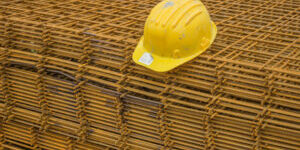Here are the advantages and disadvantages of concrete steel mesh point by point:
The compressive strength of concrete is very good, but its tensile and flexural strengths are less impressive. However, concrete structures typically experience all three types of forces. Therefore, solutions were sought to increase tensile and flexural strength, which is where steel mesh comes into play.
The use of concrete steel mesh for reinforcing concrete has been in practice since the 1800s.
For most of us, there isn’t even another solution in mind when we’re constructing a concrete structure. Yet, there are numerous instances where we pour concrete at home.
- Base concrete
- Sidewalk
- Car parking space
- Manholes
- Pergola
- Filling of formwork blocks
- Stairs
- etc.
Many will not appreciate this article because they believe that proven methods need to be defended against innovators. I didn’t write it for them. It’s intended for those who drive the world forward and always seek more efficient or environmentally friendly solutions
The advantages of concrete steel mesh:
- Strengthens the concrete, especially its tensile and flexural strength.
- Accessible to almost anyone.
- Proven effectiveness for two centuries.
- Available in large quantities.
- Provides employment opportunities for many people worldwide in both manufacturing and installation.
The disadvantages of the concrete steel mesh:
- Due to its high weight, transportation is expensive,
- Large-sized trucks are needed for transportation even for small quantities,
- It corrodes,
- Its production process causes significant environmental pollution,
- Loading and installation are physically demanding tasks,
- Storage may not be feasible everywhere,
- Installation is labor-intensive and slow,
- Poses risks of accidents,
- The prices of concrete mesh are sky-high,
- It drives immense financial profits for large industrial companies, making it very difficult to circumvent.
Okay, but what can we do to avoid these disadvantages and still have strong concrete?
The reinforcement of concrete with various fibers dates back to the Roman era. However, the real breakthrough began 2-3 decades ago when concrete industry experts started developing various synthetic fibers. These fibers have been used and continuously improved for decades.
I write more about it here: What is ArmoTec? What are static concrete macro fibers?
What can these static macro fibers do that the steel mesh can?
- -They strengthen the tensile and flexural strength of concrete.
- They are almost accessible to anyone now at.
- They are available in large quantities.
- Their global market price is raw material-dependent, but transportation costs do not significantly influence it.
What can’t they do that the welded mesh can?
- It hasn’t been proven for two centuries, just for two decades.
- It doesn’t provide as many jobs as the manufacturing of steel mesh.
- It doesn’t completely replace all types of steel reinforcement in some structures, so in certain cases, only part of the steel can be substituted with static macro fibers.
What can the structural macrofiber do that the concrete steel mesh cannot?
- -Due to its light weight, transportation costs are significantly low.
- -Its compact size allows transportation of enough material in a car trunk that is sufficient for reinforcing 20 m3 of concrete, replacing 1000 kg of steel.
- It doesn’t corrode, ensuring that the produced concrete is far more durable and doesn’t degrade over time.
- It reinforces the concrete in three dimensions, unlike traditional steel mesh, which works in two dimensions.
- It has a much lower environmental impact compared to mesh, boasting a 70% smaller ecological footprint during production.
- Easy to handle during loading, and its storage is feasible anywhere.
- Installation requires zero labor, significantly accelerating the construction process.
- It doesn’t pose any safety hazards.
And a few more advantages I haven’t mentioned yet:
- In most cases, it is cheaper than concrete steel mesh,
- increases the concrete’s water resistance,
- enhances its resistance against aggressive substances,
- and boosts the concrete’s fire resistance.
There have always been pioneers and followers.
At first, innovators are mocked, then they are criticized, and eventually, they are seen as essential. Edison’s light bulbs were also initially distrusted, but quickly became an indispensable part of every household.
My belief is that the future in the field of concrete lies with the structural macrofibers. They will increasingly replace concrete steel and simplify concreting. Moreover, there are also so-called FPR rods and meshes emerging. These are glass fiber-reinforced composite materials reinforced with resin, fully capable of replacing concrete steel in any reinforced concrete structure. They are much lighter, with significantly higher tensile strength than concrete steel mesh, they do not corrode, are easier to transport, and have numerous other advantages. I will cover this in another article.”
If you’ve made it this far into the reading, you’re also among the innovators. If you’d like to know more, visit:
Or check out the one-minute summary here: https://youtu.be/WLcgC2BRpGg
Regards,
Levente Siposs
A supporter of sustainable renovations








